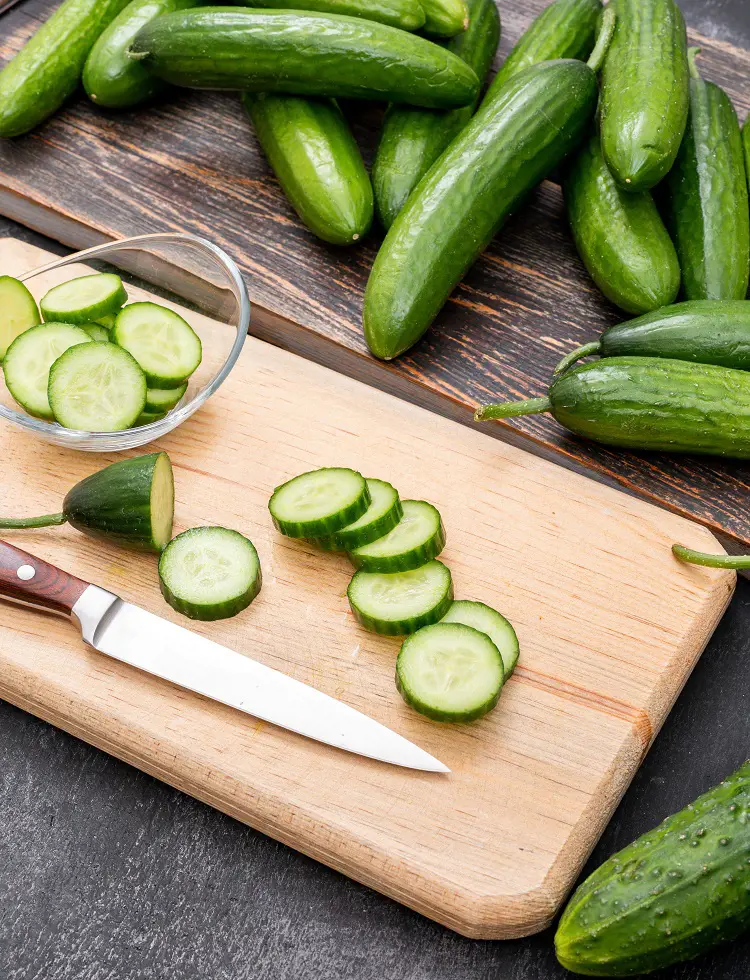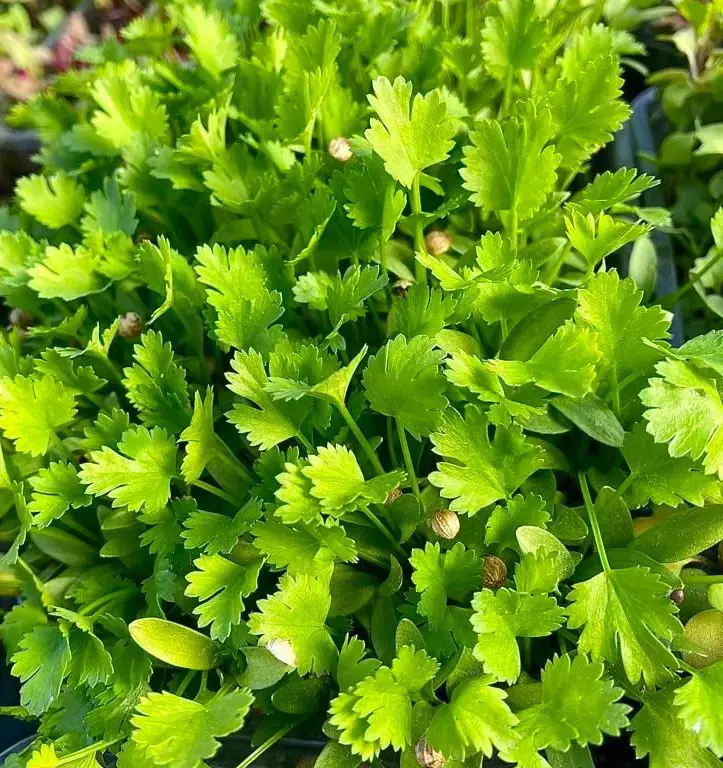How To Store Asparagus To Keep Them Fresh
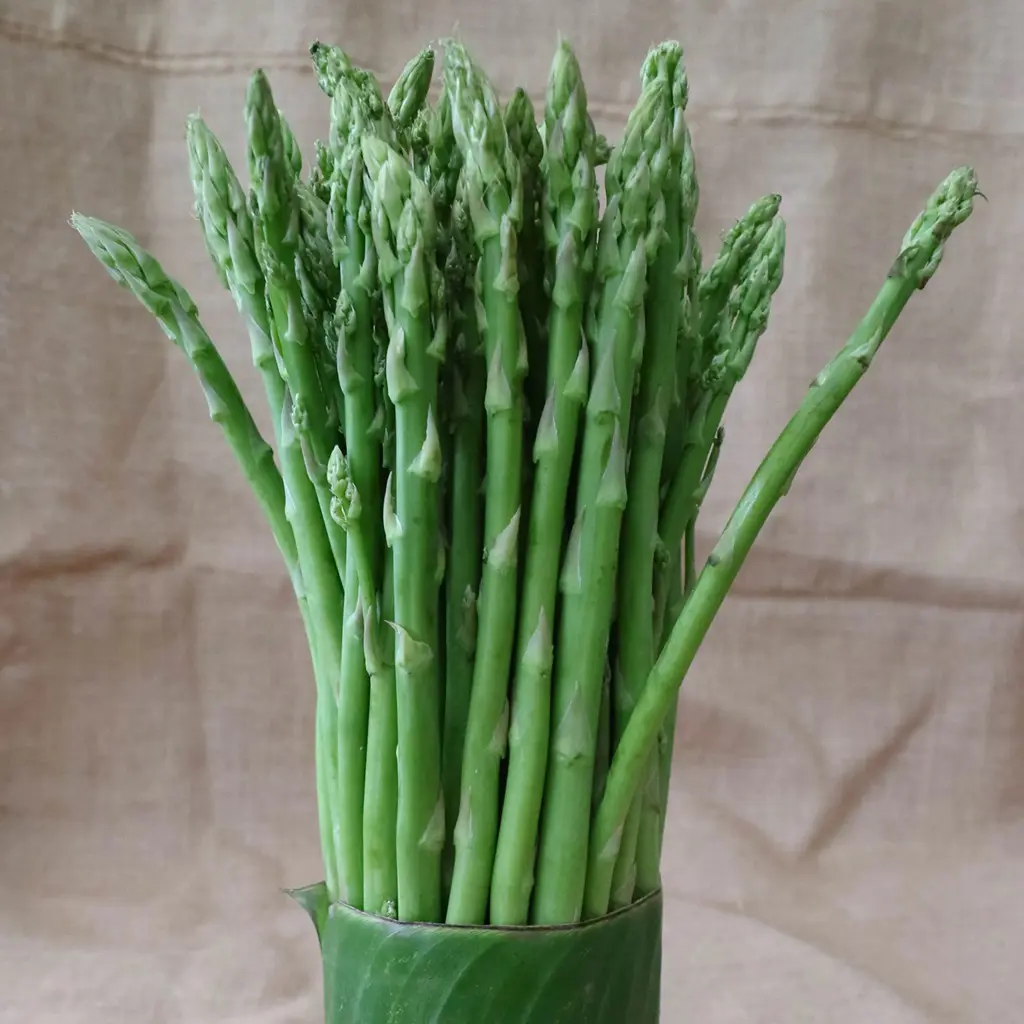
This post may contain affiliate links. If you make a purchase through links on our site, we may earn a commission.
Asparagus is a tasty, thin veggie that pops up in spring, especially in April and May. It's a bit tricky to grow asparagus at home because it's only around for a short time. Yet, its yummy taste and health benefits make it a must-have in many dishes.
In this guide, we'll look at easy ways to make your asparagus stay good for more than a week.
Refrigeration In Water
To store asparagus in the refrigerator with the water method, begin by trimming the tough ends of the spears. Place them upright in a jar or glass with approximately an inch of water, ensuring the cut ends are submerged. Cover the top of the container with a plastic bag and secure it with a rubber band.
This makeshift greenhouse helps maintain humidity, preventing dehydration and keeping the asparagus fresh. Refrigerate the setup, changing the water every few days to ensure it stays clean and the asparagus remains crisp.
Damp Cloth Wrap
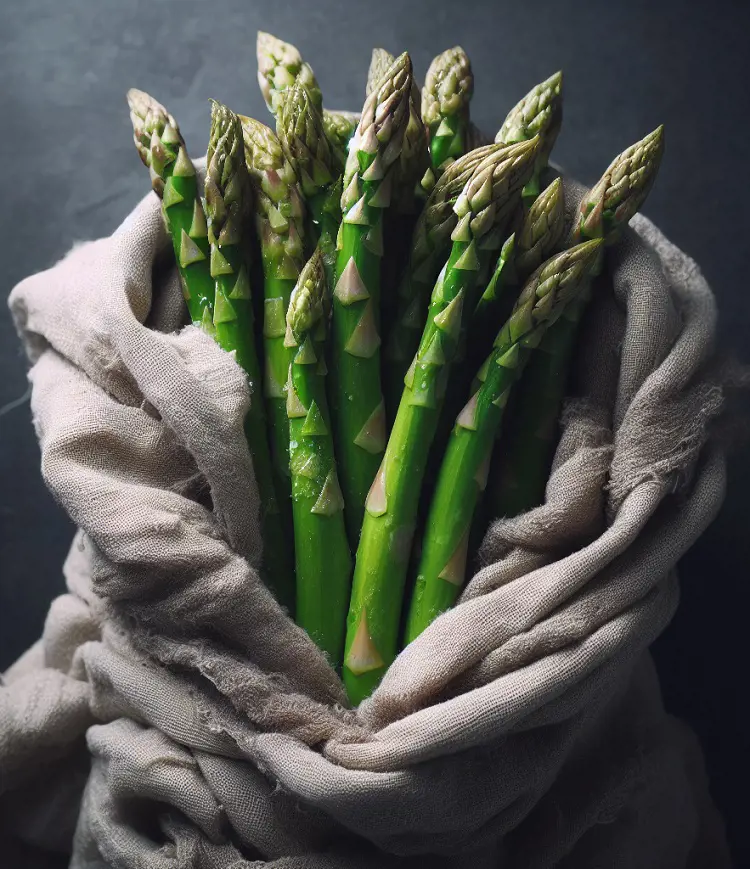
For optimal storage of asparagus, employ the damp cloth wrap method by encasing the bunch in a moistened cloth or paper towel before placing it in the refrigerator. This technique serves to regulate moisture levels, creating a protective barrier that shields the delicate stalks from drying out.
The damp environment mimics the ideal conditions for asparagus preservation, ensuring the vegetable stays crisp and flavorful. By safeguarding against dehydration, this simple and effective method contributes to prolonging the freshness of your asparagus, allowing you to enjoy its vibrant taste and texture for an extended period.
Standing in a Container
Create an asparagus haven by standing the spears upright in a container with approximately an inch of water, reminiscent of arranging flowers in a vase. This method ensures the cut ends are submerged, maintaining the vegetable's hydration and crispness.
To preserve freshness, cover the asparagus tops with a plastic bag, securing it to create a protective environment. This prevents moisture loss and shields the delicate tips. By mimicking the principles of floral care, this approach extends its shelf life, allowing you to savor the vibrant flavor and texture for an extended duration.
Plastic Bag in the Crisper
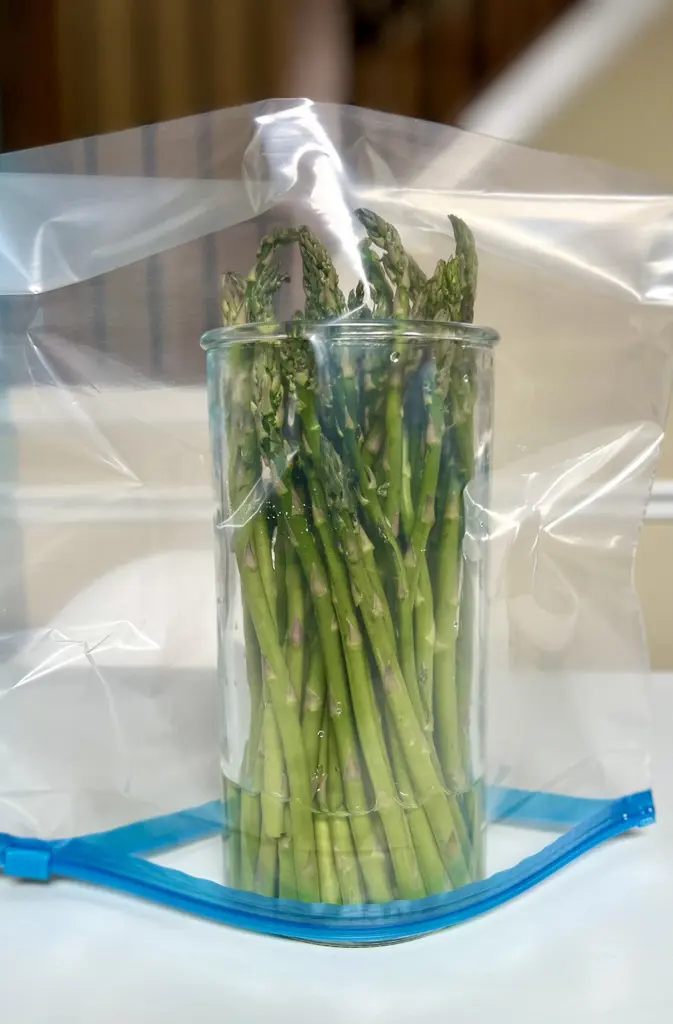
Effortlessly preserve the freshness of asparagus by storing it in the vegetable crisper drawer of your refrigerator in a perforated plastic bag. Begin by placing the trimmed asparagus spears inside the bag, ensuring it is loosely sealed to permit necessary airflow.
The vegetable crisper provides an environment with controlled humidity, ideal for keeping asparagus crisp and flavorful. The perforations in the plastic bag prevent excessive moisture buildup, mitigating the risk of spoilage. This method is convenient and maintains the asparagus' quality by regulating both humidity and airflow.
Vacuum Sealing
Elevate your asparagus preservation game with a vacuum sealer, a smart investment for extended freshness. Begin by trimming the asparagus spears and placing them in a vacuum-sealer bag. Utilize the vacuum sealer to remove excess air from the bag, creating an airtight seal that locks in the vegetable's crispness and vitality.
The absence of air slows down the oxidation process, preserving the asparagus for a more extended period in the refrigerator. This method not only minimizes the risk of dehydration but also safeguards against the entry of contaminants, ensuring that your vacuum-sealed asparagus remains as fresh as the day you sealed it.
Freezing Techniques
Preserve the vibrant color and texture of asparagus through an effective freezing technique. Begin by briefly blanching the asparagus in boiling water; this helps to deactivate enzymes that can lead to loss of color and texture during freezing.
After blanching, promptly transfer the asparagus to an ice water bath to stop the cooking process.
Once cooled, pat them dry and arrange in a single layer on a tray to prevent sticking. Place the blanched asparagus in airtight freezer bags, removing excess air before sealing to minimize the risk of freezer burn. This technique ensures that your frozen asparagus maintains its quality.
Aluminum Foil Wrap
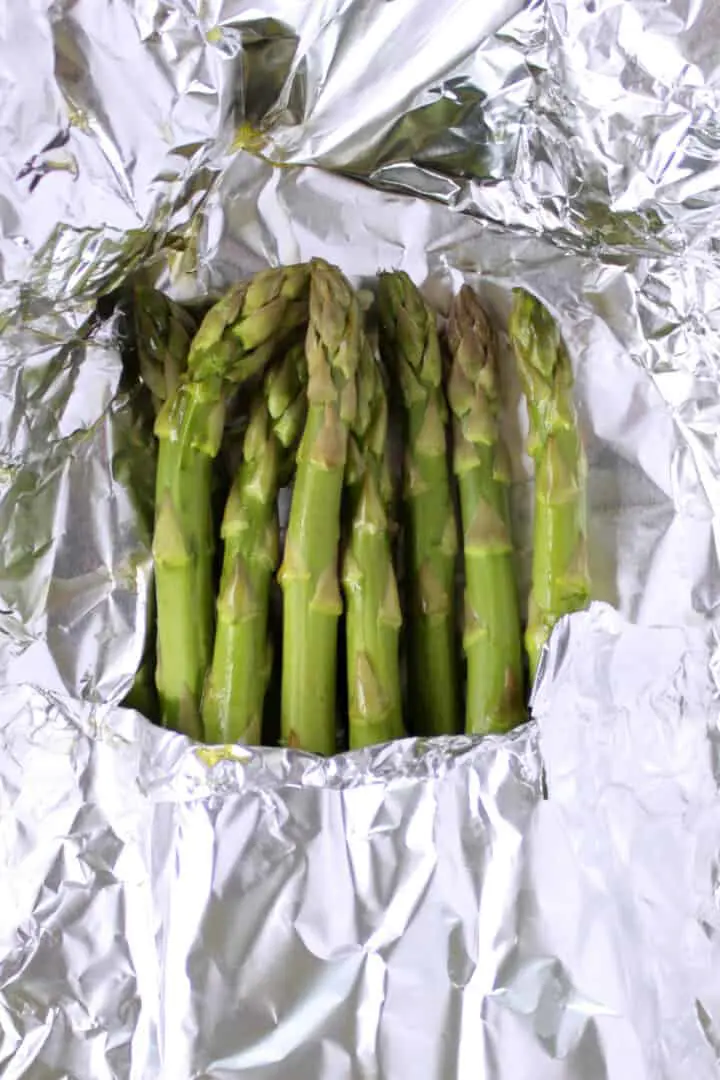
To safeguard your asparagus and maintain its freshness in the refrigerator, employ the aluminum foil wrap method. Begin by dampening a sheet of aluminum foil. Place the asparagus bunch in the center of the foil and tightly wrap it, ensuring a secure seal.
This protective layer acts as a barrier against moisture loss, preventing the asparagus from drying out. The dampness in the foil helps maintain an environment conducive to preserving the vegetable's crispness and flavor. Stored in the refrigerator, the aluminum foil-wrapped asparagus remains shielded from external elements.
Use a Produce Saver Container
These specialized containers create an optimal storage environment by regulating humidity levels. The venting mechanisms allow for controlled airflow, preventing excess moisture buildup that can lead to spoilage. Investing in these containers is a convenient and efficient way to extend the freshness of your asparagus, as they are designed to mimic ideal conditions for vegetable preservation.
By maintaining the right balance of humidity, produce-saver containers ensure that your asparagus stays crisp, vibrant, and ready for culinary use over an extended period, making them a valuable addition to your kitchen storage solutions.
Store in a Jar With Olive Oil
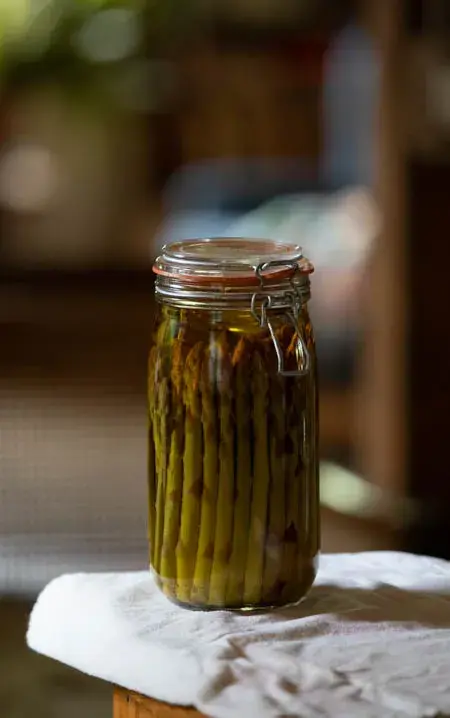
For a tasty and fresh twist, trim asparagus and pop it into a jar filled with olive oil. The oil not only adds flavor but creates a seal, keeping the asparagus crisp and delicious. Make sure the spears are fully submerged in the oil to prevent air from reaching them.
Stored in the fridge, this method not only enhances the asparagus taste but also extends its shelf life. When you're ready to use them, the olive oil-infused asparagus can be a flavorful addition to salads, and pastas, or enjoyed on their own.
Pickling

Pickling is a simple and tangy preservation method. Prepare a straightforward pickling solution by combining vinegar, water, salt, and sugar. Trim the asparagus spears to fit your container, submerge them in the pickling solution, and store the concoction in the fridge.
This process infuses the asparagus with a delightful combination of flavors while simultaneously extending its shelf life. Pickled asparagus makes for a versatile addition to salads, charcuterie boards, or as a zesty snack. With minimal effort, you can enjoy the unique taste of pickled asparagus, adding a flavorful twist to your culinary repertoire.
Dehydrating
Opt for dehydrating as a long-term storage solution for asparagus. Begin by dehydrating the trimmed spears, removing the moisture to enhance shelf life. Once dehydrated, store the asparagus in an airtight container. When ready to use, rehydrate the asparagus by soaking it in water before incorporating it into your dishes.
This method not only preserves the vegetable for an extended duration but also retains its nutritional value. Dehydrated asparagus becomes a versatile ingredient, ready to add a burst of flavor to soups, stews, or casseroles.
Asparagus Pesto Ice Cubes
Start by blanching the asparagus to preserve its vibrant color and nutritional value. Puree the blanched asparagus with garlic, olive oil, and a pinch of salt, creating a flavorful pesto. Transform this concoction into user-friendly portions by freezing it in ice cube trays.
Each cube encapsulates the distinct taste of asparagus, ready to enhance pasta, pizzas, or spread on toast. These frozen flavor bombs add a burst of freshness to your dishes, making meal preparation a breeze with perfectly portioned asparagus pesto.
Tips to Select the Fresh Asparagus For Storing
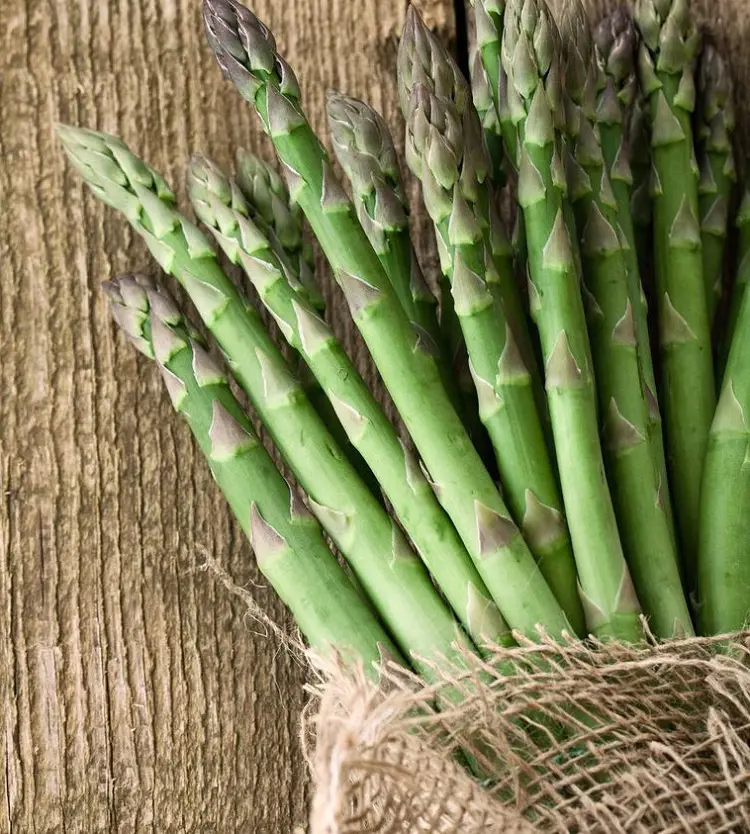
It's no surprise that a crucial aspect of preserving asparagus for an extended duration involves selecting the finest quality right at the supermarket or farmer's market. Keep an eye out for asparagus stalks that meet the following criteria:
- Choose asparagus with lively, colorful tips, either bright green or violet, and featuring firm, compact buds.
- Choose stalks that stand upright, exhibiting a firm yet slightly flexible texture and smooth skin.
- Check for asparagus with moist cut ends, avoiding excessively dry, woody, or split stems.
- Ensure there are no indications of spoilage, such as mold, wilting, or unpleasant rancid smells.
How Long Does Fresh Asparagus Last?

The shelf life of fresh asparagus depends on how it's stored. Here are general guidelines for different storage methods:
- Refrigeration: Fresh asparagus stored in the refrigerator typically lasts 1 to 2 weeks. To extend its freshness, consider methods like refrigeration in water or using produce-saver containers.
- Freezing: When properly blanched and frozen, asparagus can last for up to 8-12 months in the freezer.
- Canning: Canned asparagus, when stored in a cool, dark place, can last for up to a year or more.
- Dehydrating: Dehydrated asparagus, if stored in an airtight container in a cool, dark place, can last for several months.
Remember that these are general estimates, and actual freshness may vary based on factors like initial quality, storage conditions, and proper handling. Always check for signs of spoilage, such as off odors, discoloration, or mold, before using.
How To Tell If Asparagus Is Bad?
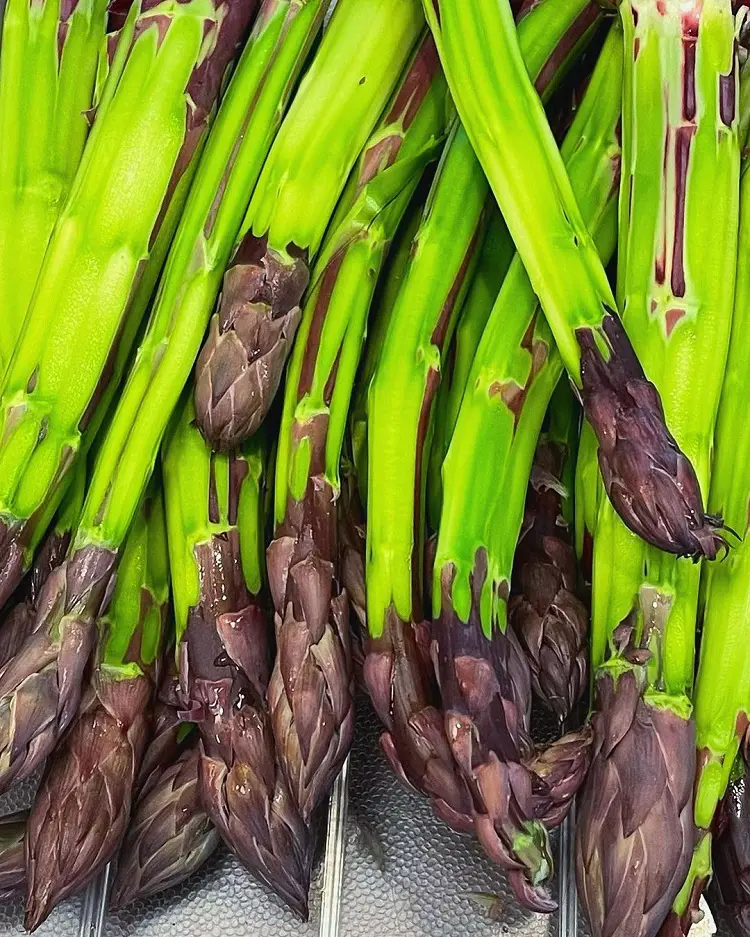
Identifying whether asparagus has gone bad involves checking for various signs of spoilage. Here's how to tell if asparagus is no longer good to eat:
- Appearance: Look for color changes. Fresh asparagus should have vibrant green or violet tips. If it turns yellow or has a dull appearance, it may be past its prime.
- Texture: Fresh asparagus should be firm and have a slightly moist texture. If it becomes limp, slimy, or excessively dry, it may have deteriorated.
- Smell: Spoiled asparagus may emit a foul or rancid odor. Fresh asparagus should have a mild, earthy aroma.
- Mold: Check for any signs of mold, especially around the tips or along the stalks. Discard asparagus with visible mold growth.
- Browning: Brown discoloration, especially at the tips, could indicate deterioration. Fresh asparagus should have minimal browning.
If you notice any of these signs, it's best to discard the asparagus to avoid consuming spoiled or potentially harmful food. Always store asparagus properly to maximize its freshness and shelf life.
Conclusion
By implementing these clever storage techniques, you can prolong the life of your asparagus, ensuring that each meal is infused with the crispness and flavor this delightful vegetable offers.
Experiment with different methods to find the one that suits your preferences and kitchen routine best. Enjoy your fresh asparagus for longer, and say goodbye to unnecessary food waste!
Recent posts
How To Store
How To Store
How To Store Cucumbers
A good cucumber is cool, crunchy, and refreshing, but if you don't store it right, it can turn mushy and not good to eat. To keep cucumbers fresh, store them where they can get air and not too wet. Now, let's talk about different ways to keep cucumbe...
How To Store
How To Store Garlic Properly
Garlic is a kitchen pioneer important for adding flavor and depth to countless dishes. However, if stored incorrectly, garlic may lose its potency or even go bad. When stored properly a fresh garlic bulb can last up to six months otherwise, it will o...
How To Store
How To Store Potatoes - 15 Simple Tricks
Potatoes are a versatile vegetable loved for ages. From French fries to baked potatoes, there are many ways to enjoy them and they also naturally have a long shelf life. However, it is concerning that they can't last long without proper precautions. ...
How To Store
How To Store Carrots So They Last Longer
Carrots typically last for days and weeks at room temperature. If stored properly using the right technique, it can last for several months too. From harvesting to freezing, several ways can help extend the carrots’ shelf life. In this gu...
How To Store
How To Store Avocados Long Term
Avocado is a delicious, yet highly perishable fruit with nutritive benefits. Its high metabolic rate is the major contributing factor to its shorter shelf-life. The shelf-life of avocados ranges from 3-4 weeks when stored at the ideal temperature and...
How To Store
How To Store Cilantro Leaves
Cilantro is an indispensable item in our kitchen. Cilantro's seeds, leaves, and stems can all be consumed and can be used in many dishes around the world including sauces, soups, curries, etc. Cilantro is a good option because of its pleasant scent, ...
